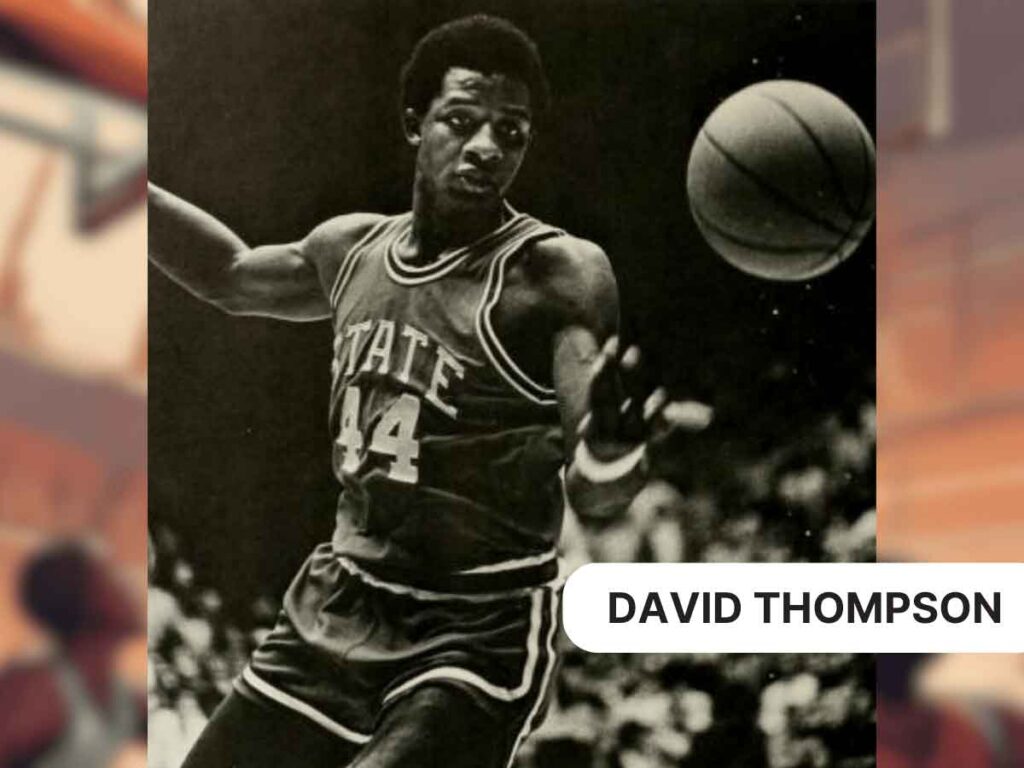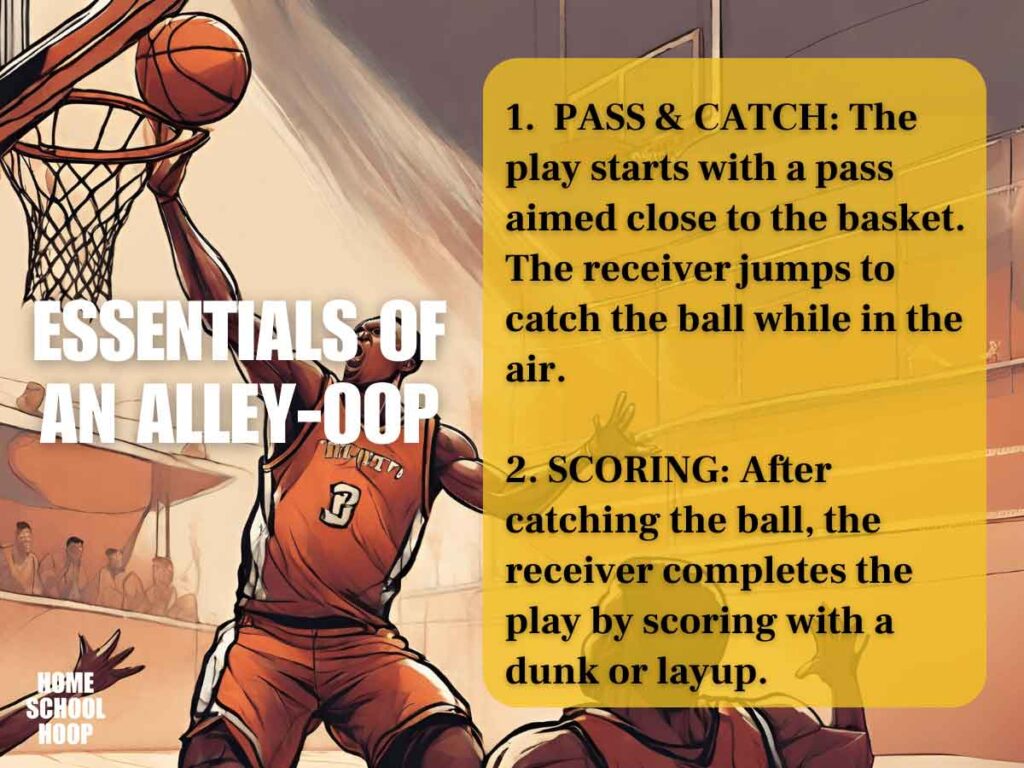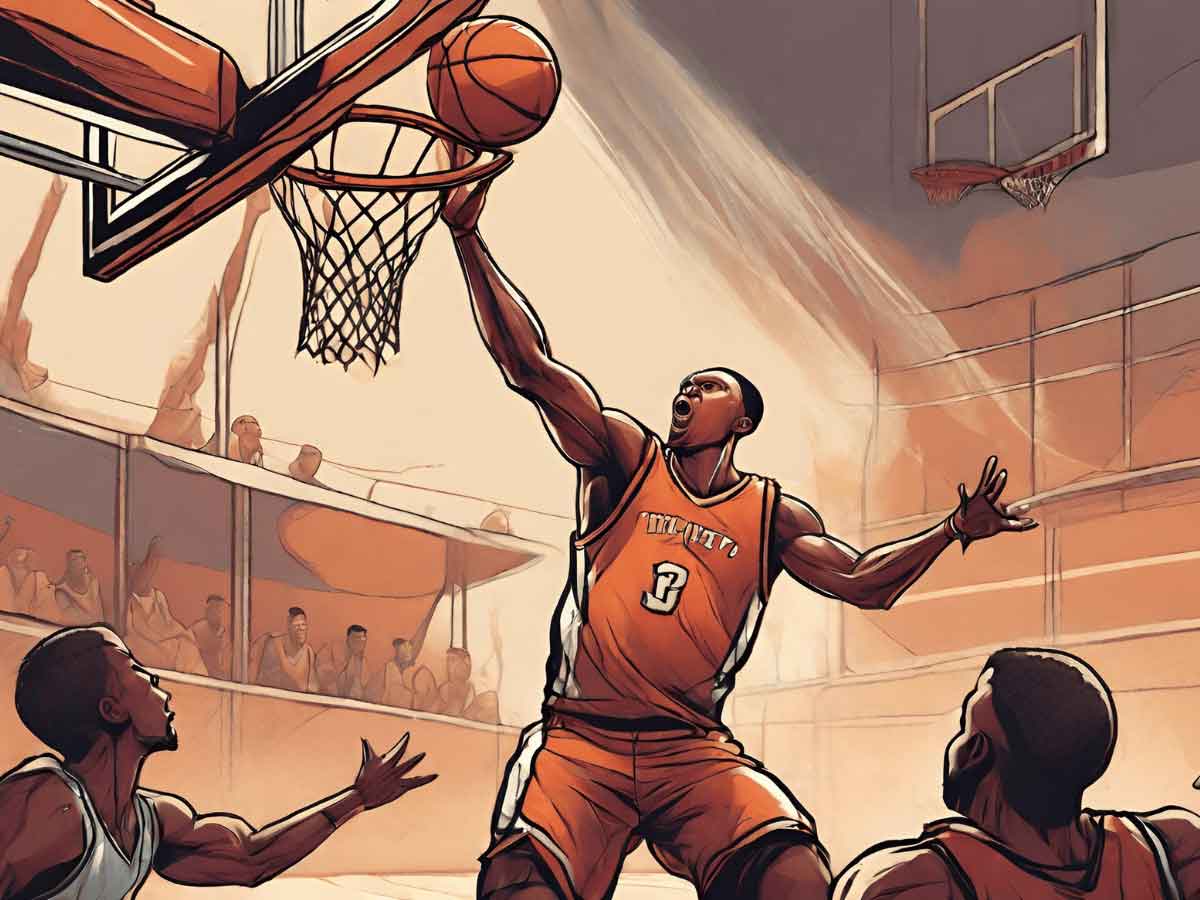Aside from a buzzer-beater, is there anything in basketball more exciting than the alley-oop? One player lobs the ball just right, close to the hoop, and then a teammate leaps, grabs the ball mid-air, and scores, all without their feet touching the ground. It takes coordination and timing from the passer and some high-flying athleticism by the scorer.
Key Takeaways:
- An alley-oop in basketball blends a pass and a basket into one smooth, crowd-hyping move.
- Pulling it off takes a ballet of timing, teamwork, and skill between the player throwing the ball and the one finishing the play.
- The play gets fans and players hyped, which can swing the game’s momentum.
Think of the alley-oop as the play that says, “I’ve got you.” It’s the ultimate symbol of partnership and trust among teammates. Through this guide, we hope to give you a deeper appreciation of the iconic basketball play; we’re going to unpack the alley-oop, from its roots to the nitty-gritty of pulling it off, showing you why it’s not just an exciting play but a strategic and athletic masterpiece.
What is an Alleyoop in Basketball?
An alley-oop is one of those jaw-dropping moments in basketball that has everyone in the stands (and watching from home) up out of their seats. It happens when one player tosses the ball up near the basket, perfectly timed for another player to leap, catches it in mid-air, and scores. They might slam it down with a dunk or finesse it through the net with a shot, all before their feet touch the ground again.
Take a look at some of the most breathtaking alley-oop dunks and layups:
The Anatomy of an Alley-Oop
So, what exactly ticks all the boxes for a play to earn the alley-oop badge of honor? The offensive score has to meet this criteria:
- Aerial Pass: First up, the ball is passed in such a way that it travels near the basket and within reach of a leaping player.
- Mid-Air Catch: This is where the excitement starts. The receiving player leaps to catch the ball.
- Seal the Deal: While still in the air, the player lays the ball up, dunks, or shoots, all before landing back on the court.
And hey, let’s not forget that alley-oops aren’t limited to male players. Check out Frank Belibi making high school history by throwing down an alley-oop dunk:
Learn more: Curious about more dunking feats? Find out how many dunks have there been in the WNBA.
TRIVIA:
What two players executed arguably the best alley-oop in NBA history?
Clue 1: This alley-oop dunk happened in a 2013 regular season NBA game between the Los Angeles Clippers and the Detroit Pistons.
Clue 2: The two players were teammates on the Los Angeles Clippers for six seasons.
Clue 3: The dunk put defender Brandon Knight on the floor and caused a temporary game stoppage.
Scroll to the bottom for the answer.
The History of the Alley-Oop
Ever wonder where the alley-oop came from? It’s got a backstory as interesting as the move itself. “Alley-oop” borrows its flair from a French phrase acrobats use, “allez hop!”, right before they leap into something spectacular. It’s the perfect name for a basketball move that’s an acrobatic stunt, right?
Here’s a fun fact: before basketball ever knew about the alley-oop, football was using the term. Back in the ’50s, the San Francisco 49ers were known for throwing their alley-oop passes, tossing the ball high and far, with receivers outjumping opponents to make dramatic catches.
The Alley-Oop Hits the Court
But let’s talk about when basketball started to get into the alley-oop game. It wasn’t a thing until the 1970s when college teams like North Carolina State started to light up the scoreboard with it. Players like David Thompson and his crew, Monte Towe and Tim Stoddard, made the alley-oop an integral part of their offensive plays, soaring through the air and slamming the ball down.

Fast forward to 1983, in a nail-biter of a college championship game. NC State’s Derek Whittenberg launches the ball from way downtown as the clock’s ticking down. The shot’s way off, but Lorenzo Charles is right there under the hoop. He jumps, catches the off-target shot mid-air, and dunks it for the win. It was all fair game and not considered goaltending in basketball; a stunning play that remains one of the most memorable college championship moments.
The NBA Gets in on the Action
After that, the NBA adopted the alley-oop and transformed it, as the best athletes only can. What started as a smart way to score turned into the highlight of the game. The alley-oop became the ultimate show of teamwork, dominance, and high-flying skills, with NBA players turning it into an art form.
The Mechanics of a Perfect Alley-Oop
Pulling off an alley-oop is like a secret handshake by two players: one sets up the play (the passer), and the other finishes it with a score (the receiver).

Setting the Stage: The Passer’s Role
The play starts with the passer, the architect of the alley-oop. They’re tasked with delivering a pass aimed close to the basket. Doing this takes:
- Seeing the Future: The passer has to predict how the play will unfold before it happens, anticipating the receiver’s movement and reading the defender’s positions.
- Perfect Timing: They’ve got to throw the ball at the right moment. Too early or too late, and the play falls apart (and likely leads to a turnover in basketball).
- Pinpoint Accuracy: The pass has got to be precise for a successful basketball assist, leading the receiver so they can do their thing–catch and shoot the ball in their jump trajectory.
Taking Flight: The Receiver’s Role
The receiver completes the play by scoring. This is often a dunk, but can also be a layup or shot. It’s not only about jumping high; there’s a bit more to it:
- Reading Minds: The receiver has to read what the passer is thinking and when they’re going to launch the ball their way. This kind of telepathy comes from lots of time playing with each other in practices, scrimmages, and games.
- Athleticism: It takes serious hops (jumping ability) to meet the ball at its highest point and have time to score before landing.
- Coordination: Catching and scoring in one fluid motion is harder than it looks. It takes top-notch hand-eye coordination and body control.
Learn more: Curious about basketball and growth spurts? Check out our article, Does Playing Basketball Make You Taller?
Memorable Alley-Oop Moments in Basketball
Let’s take a walk down memory lane and revisit some of the most unforgettable alley-oop moments from both the NBA and WNBA.
NBA Highlights
The Iconic Duo: One of the most iconic alley-oops in NBA history features Shaquille O’Neal and Kobe Bryant of the Los Angeles Lakers. In Game 7 of the 2000 Western Conference Finals against the Portland Trail Blazers, Kobe tossed it up, Shaq threw it down, sealing the game and the series. This propelled the Lakers toward their first championship of the Shaq-Kobe era.
The King Takes Flight: LeBron James has been on both ends of alley-oops, but his most memorable have involved catching a pass from Dwyane Wade during their time together on the Miami Heat. The two had remarkable chemistry, and that photo of Wade with his arms outstretched as LeBron flies in for the dunk behind him has become iconic.
Find out: See our list of the best Shaq quotes or discover who has the most rings in the NBA.
WNBA Highlights
The Sun’s Dynamic Duo: The Connecticut Sun’s Natisha Hiedeman and Jonquel Jones showed off their chemistry with a stunning alley-oop one-handed layup against the Las Vegas Aces. Watch it unfold here.
Parker’s Poise: While with the Los Angeles Sparks, Candace Parker executed a brilliant spin move off her defender to complete a one-handed alley-oop, thanks to a well-placed pass from Kristi Toliver. See the moment here.
Storm Surge: The Seattle Storm’s Breanna Stewart and Jewell Loyd connected for a seamless alley-oop that showcased their on-court synergy. Catch this play here.
Learn more: Who are the tallest WNBA players?
FAQs
Why do they call it an alley-oop?
The term “alley-oop” comes from the French phrase “allez hop!” which acrobats use to signal their jump.
What does alley-oop mean in slang?
In slang, “alley-oop” refers to a surprising or well-coordinated move, not just in sports but in any situation where teamwork is key. It refers to setting someone up for a successful finish.
What is the difference between an alley-oop and a lob pass?
A lob pass is a type of pass where the ball is thrown in a high arc to a spot on the court. An alley-oop is a specific kind of lob pass aimed near the basket, where the receiver catches it mid-air to score. All alley-oops are lob passes, but not all lob passes are alley-oops.
Who invented the alley-oop dunk?
The alley-oop dunk was popularized in basketball by NC State players David Thompson and Monte Towe in the early 1970s. They used it as a strategy to score points by capitalizing on Thompson’s high-jumping ability.
YOUR FAVORITE MOMENT
Today, you learned about the alley-oop in basketball.
So we want to know: What’s your most memorable alley-oop moment, either from watching a game or playing in one?
Share your story or your favorite game highlight in the comments.
The TRIVIA answer is Chris Paul and DeAndre Jordan.


